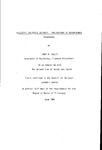SUCCESSIVE INCENTIVE CONTRAST: IMPLICATIONS OF DECONFOUNDED PROCEDURES
| dc.contributor.author | COLLIS, JANET M. | |
| dc.contributor.other | School of Psychology | en_US |
| dc.date.accessioned | 2013-09-11T09:24:45Z | |
| dc.date.available | 2013-09-11T09:24:45Z | |
| dc.date.issued | 1983 | |
| dc.identifier | NOT AVAILABLE | en_US |
| dc.identifier.uri | http://hdl.handle.net/10026.1/1649 | |
| dc.description.abstract |
This thesis reports a series of investigations into the incentive contract effect. From a review of the literature, it was concluded that a clear distinction should be made between the effects of conventional and deconfounded contrast procedures. Different experimental apparatus also appeared to be important in determining subsequent effects of reward magnitude shifts. The present investigations consisted of six experiments employing a deconfounded procedure and one experiment employed a conventional procedure. Experiment I established contrast effects with a free operant deconfounded procedure. Experiment II showed that previously established runway contrast effects (with a conventional procedure) could be used in subsequent studies. Experiments III-V demonstrated reverse contrast effects with a deconfounded runway procedure. An hypothesis is presented to account for these discrepancies. It is proposed that the compatibility of the preshift experience and the postshift response for food is crucial in the determination of the ‘direction’ of subsequent postshift effects in deconfounded procedures, (reverse or otherwise). If preshift experience ‘adds’ to the acquisition of the postshift response, reverse contrast effects should occur, and if preshift experience ‘subtracts’ from the acquisition of the postshift response, contrast effects should occur. Experiments VI and VII tested the compatibility account in the runway and predictions were supported. ‘Forward’ preshift placements prior to postshift running trials led to a suggestion of reverse contrast effects and ‘backward’ preshift placements prior to postshift running trials led to contrast effects. The overall findings of this thesis are reviewed with reference to current theories of incentive contrast and it is proposed that the deconfounded contrast literature can be more adequately encompassed within a compatibility account. However, the explanation for contrast effects obtained with conventional procedures necessitates the inclusion of an expectancy construct. | |
| dc.language.iso | en | en_US |
| dc.publisher | University of Plymouth | en_US |
| dc.title | SUCCESSIVE INCENTIVE CONTRAST: IMPLICATIONS OF DECONFOUNDED PROCEDURES | en_US |
| dc.type | Thesis | |
| plymouth.version | Full version | en_US |
| dc.identifier.doi | http://dx.doi.org/10.24382/4354 | |
| dc.identifier.doi | http://dx.doi.org/10.24382/4354 |
Files in this item
This item appears in the following Collection(s)
-
01 Research Theses Main Collection
Research Theses Main


